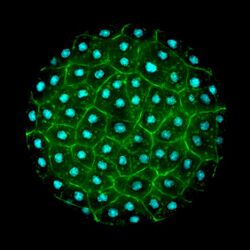Biology:Sphaeroforma arctica
| Sphaeroforma arctica | |
|---|---|

| |
| Sphaeroforma arctica stained with phalloidin and DAPI | |
| Scientific classification | |
| Domain: | Eukaryota |
| (unranked): | Holozoa |
| Class: | Ichthyosporea |
| Order: | Ichthyophonida |
| Family: | Creolimacidae |
| Genus: | Sphaeroforma |
| Species: | S. arctica
|
| Binomial name | |
| Sphaeroforma arctica Jøstensen, Sperstad, Johansen & Landfald, 2002[1]
| |
Sphaeroforma arctica, is a unicellular eukaryote with a pivotal position in the tree of life. It was first isolated from the arctic marine amphipod Gammarus setosus.[2][1] Like other Ichthyosporeans such as Creolimax and Abeoforma, Sphaeroforma arctica are spherical cells characterized with their capacity to grow into multi-nucleated coenocytes (multi-nucleates cell). However, a unique feature of S. arctica, is that no obvious budding, hyphal, amoeboid, sporal or flagellated growth stages have been observed in laboratory growth conditions.
Taxonomy
Sphaeroforma is a member of the Ichthyosporea clade, which is the earliest branching holozoan lineage. It is a key organism to understand the origin of animals.
Applications
Sphaeroforma arctica grows easily in marine broth, with the particularity of growing synchronously.[3][4] From a cell with 1 single nucleus (although newborn cells have been shown to contain 2 or even 4 nuclei, too[4]), it can grow to reach a 128 nuclei cell before undergoing cellularization (the process by which the coenocytes split up to give new-born cells). Cellularization involves coordinated inward plasma membrane invaginations dependent on an actomyosin network that leads to the formation of a polarized layer of cells resembling an epithelium. This process is associated with tightly regulated transcriptional activation of genes involved in cell adhesion.[5]
Moreover, it has been recently shown that S. arctica contains miRNA as well as the complex miRNA processing machinery. Taken together, Sphaeroforma arctica is a great model organism from both evolutionary and cell biology perspectives.[6]
References
- ↑ 1.0 1.1 Jøstensen, Jens-Petter; Sperstad, Sigmund; Johansen, Steinar; Landfald, Bjarne (2002-01-01). "Molecular-phylogenetic, structural and biochemical features of a cold-adapted, marine ichthyosporean near the animal-fungal divergence, described from in vitro cultures". European Journal of Protistology 38 (2): 93–104. doi:10.1078/0932-4739-00855.
- ↑ Marshall, Wyth L.; Berbee, Mary L. (March 2013). "Comparative morphology and genealogical delimitation of cryptic species of sympatric isolates of Sphaeroforma (Ichthyosporea, Opisthokonta)". Protist 164 (2): 287–311. doi:10.1016/j.protis.2012.12.002. ISSN 1618-0941. PMID 23352078.
- ↑ Suga, Hiroshi; Ruiz-Trillo, Iñaki (2013-05-01). "Development of ichthyosporeans sheds light on the origin of metazoan multicellularity". Developmental Biology 377 (1): 284–292. doi:10.1016/j.ydbio.2013.01.009. ISSN 0012-1606. PMID 23333946.
- ↑ 4.0 4.1 Ondracka, Andrej; Ruiz-Trillo, Iñaki (2017-09-19). "Decoupling of the nuclear division cycle and cell size control in the coenocytic cycle of the ichthyosporean Sphaeroforma arctica". bioRxiv 10.1101/190900.
- ↑ Dudin, Omaya; Ondracka, Andrej (24 October 2019). "A unicellular relative of animals generates a layer of polarized cells by actomyosin-dependent cellularization". eLife 8. doi:10.7554/eLife.49801. PMID 31647412.
- ↑ Brate, Jon; Neumann, Ralf Stefan; Fromm, Bastian; Haraldsen, Arthur Alexander Blorstad; Grini, Paul; Shalchian-Tabrizi, Kamran (2016-10-01). "Pre-metazoan origin of animal miRNAs". bioRxiv 10.1101/076190.
Wikidata ☰ Q11950312 entry
 |


